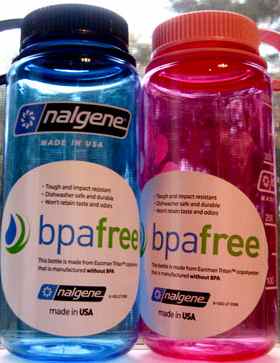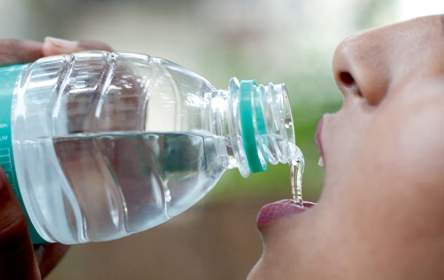lingering concerns over plastics
BISPHENOL-A AND TOXICITY

by
BETSY L. CHUNKO
_________________________________________
Betsy
Chunko is currently an American research fellow at the Institute
for Cultural Studies at Humboldt University in Berlin, Germany.
In
March 2012, Campbell’s Soup announced it would stop packaging
their soups in cans containing high levels of bisphenol-A, or
BPA, a chemical endocrine disruptor. Thanks in part to a massive
Cans Not Cancer campaign launched by the Breast Cancer Fund,
the Campbell company has vowed to phase out the use of BPA in
its can linings.
Campbell’s
is just one of many companies to come under fire for reports
of high BPA levels in its packaging. A rather ubiquitous chemical
compound, BPA is commonly employed to harden plastics, though
it has numerous other uses -- one of which is related to the
production of the epoxy resins that line the inside of most
food and beverage containers.
Some
animal studies have found that BPA accelerates puberty and increases
cancer risk. The chemical has also been tied to an increased
risk of heart disease and diabetes in adults. The majority of
BPA’s bad press has been related to its questionable safety
in products made for and marketed to children.
 In
April 2008, the government of Canada took action. After seven
years of study, it listed BPA as a toxic substance under its
Environmental Protection Act. The country introduced regulations
to ban selling, advertising, manufacturing, or importing baby
bottles made with BPA-related plastics. As a result, most of
Canada’s largest retailers swiftly removed all food-related
BPA products from their shelves.
In
April 2008, the government of Canada took action. After seven
years of study, it listed BPA as a toxic substance under its
Environmental Protection Act. The country introduced regulations
to ban selling, advertising, manufacturing, or importing baby
bottles made with BPA-related plastics. As a result, most of
Canada’s largest retailers swiftly removed all food-related
BPA products from their shelves.
Meanwhile,
questions surrounding BPA-use started heating up Stateside.
On May 13, 2009, Chicago’s City Council unanimously adopted
a measure making it the first American city to ban the sale
of baby bottles and sippy cups manufactured with the chemical.
The measure was driven by what Chicago officials called federal
regulators’ failure to take action on a grave public health
issue.
Minnesota
and Connecticut became the first two states to sign BPA regulations
into law. In 2010, Maryland, Massachusetts, New York and Wisconsin
likewise banned BPA from young children’s products. Also
in 2010, Vermont and Washington passed similar but more aggressive
legislation to ban BPA in sports bottles and reusable food and
beverage containers. 
That
same year, the United States Food and Drug Administration announced
it would spend $30 million to investigate possible links between
BPA exposure and cancer. To many, this represented a small victory,
since it essentially reversed the FDA’s earlier draft
risk assessment claiming that levels found in products on the
American market appeared to be safe. In October of 2008, a scientific
panel of advisers to the FDA condemned that initial conclusion.
From 2010, the agency’s website has proclaimed, “recent
studies provide reason for some concern about the potential
effects of BPA on the brain, behavior, and prostate gland of
fetuses, infants and children.”
Despite
a lack of scientific consensus, companies such as Wal-Mart,
CVS and Babies R Us, as well as many leading makers of infant
formula, have been selling BPA-free baby products for years
already in response to mounting consumer pressures. Other major
retailers, like Nalgene, have since removed BPA-containing products
from their full line of wares. They cite solidarity with consumers
who don’t want to risk exposing their children, or themselves,
to any level of BPA.
Yet
the skeptics haven’t completely won out. Some have criticized
Walmart’s self-imposed BPA-in-baby-bottles-ban; Marc Gunther
of Fortune Magazine has argued that such moves from
retail giants are bids to assume status as a populist FDA. The
American Chemistry Council and other industry groups still maintain
that there is little evidence that the chemical harms children.
They have lobbied strenuously against bans on BPA, citing global
consensus from research scientists and government bodies proving
current levels of BPA to be within a safe range. Industry websites
(bisphenol-a.org)
and (factsonplastic.com)
continue to defend BPA. Furthermore, not all states have been
successful in passing anti-BPA legislation. Bills to ban BPA
failed to gain Senate approval in California and Oregon.
Regardless
of where the individual falls in the debate, country-wide retail
moves to initiate self-imposed BPA bans are still largely tied
to larger trends in consumer confidence. Parental fears about
the potential toxicity, or ‘unnaturalness,’ of their
children’s environments are fueled by a pervasive cultural
fire. Books such as Slow Death by Rubber Duck: The Secret
Danger of Everyday Things both capitalize on and fuel the
flames of doubt. The authors, environmentalists Rick Smith and
Bruce Lourie, decided to inhale and ingest a host of things
that are part of our everyday lives and test the effects. Their
own bodies became the reference point to tell the story of pollution
in our modern world, exposing the corrupt corporate penchant
for adding things that will make us sick to their stock, and
gutless government officials who turn a blind eye. The bottom
line? To prove that we are poisoned in our everyday lives by
malicious capitalist forces.
The
book is scary -- and that’s the point. The anti-chemical
movement is taking on Crusade-like proportions. The message
is clear: You’re either on the side of decent American
families, the little guy, the Good . . . or you’re on
the side of corporate greed and corruption. The move to purge
BPA containing products -- as well as those with a host of other
suspicion-raising culprits, such as polyvinyl chloride (PVC)
-- is getting some serious star power as well. Jessica Alba
recently began a subscription service for nontoxic baby products,
“The Honest Company.” Her website offers the rather
earnest if credulous pledge: “no bad chemicals.”
But
how far must families go -- and where are the limits? Forbes.com
called Smith and Lourie’s book “Enviro-porn.”
The review’s author, Trevor Butterworth, cites a persistent
tendency for some writers of popular scientific literature to
create “plausible scare stories.” It all boils down,
he further argues, to one, sad fact: “To the dismay of
toxicologists, enviroporn is rampant in the reporting of chemical
risks, because, let’s face it, real chemistry is desperately
unsexy.”
Indeed,
willingly exposing oneself to potentially harmful chemicals
smacks of the ridiculous and extremist. Then again, who’s
to say that the book’s deeper point, increased awareness,
is a wash? The reviewer for The Washington Post argued:
“Slow Death by Rubber Duck is hard-hitting in
a way that turns your stomach and yet also instills hope for
a future in which consumers make safer, more informed choices
and push their governments to impose tougher regulations on
the chemicals all around us.”
No
argument against that. But in his recent New York Times
article, Michael Tortorello interviews a lawyer and women’s
health advocate who admitted to tossing most of her cosmetics
and interrogating merchants by email over the potential toxicity
of their products once she became a mother. The point here seems
clear: As we root out monsters in the murky darkness of contemporary
life, we’re in danger of becoming obsessed by the shadows
all around. Weren’t lead paint and asbestos bad enough?
Now the enemy is multiplying, and he’s not just in the
walls anymore. From furniture to food containers, baby bottles
to credit cards, he’s all around us -- a constant companion
in our daily lives.
There
are many threads to tease out: public health campaigns, mass-media
madness, eco-marketing trends and a frenzied environmental movement.
The vacillating battle against BPA and similar curious compounds
is fueled, above all, by a growing sentiment in our country:
How do we protect ourselves from the dark side of manufacturing?
And more pressing: If we don’t protect ourselves and our
families, who will? What people really fear is the seemingly
unhindered proliferation of chemicals in the market-place --
and the apparent lack of options, the no-go of opting out of
the cycle of mainstream consumerism that riddles our households
with products made by companies without an eye toward stringently
safe manufacturing practices.
Another
problem is how little we seem to definitively know. We don’t
know enough, for instance, about how thousands of chemicals
may interact in the human body. And while high exposure to BPA
is a pretty certain health threat, we don’t know what
levels of BPA-exposure are actually safe over the long-term,
for children or adults. When so much seems like scientific conjecture
-- that is, when it looks like the jury is still out -- what
choice do the health-minded have but to worry, worry, worry?
After
all, there’s a big difference between citing current levels
of BPA in American consumer products as relatively safe versus
completely safe. Case in point: The 2008 Canadian review found
“negligible risk” from BPA to those older than 18
months. Obviously, that wasn’t good enough to prevent
adults from steering clear of the BPA-bandwagon themselves.
Consumers in the U.S. are sending the message that negligible
isn’t nil -- i.e., until conclusive data is available,
prevention in the form of self-protection may be the order of
the day.
The
tricky part -- balancing concern with common sense -- remains
open to debate.
Resources
for consumers:
Consumers
can take small, easy steps to limit their exposure to common
sources of BPA. American consumer plastics use a numbered system,
also called the “resin identification code.” When
it comes to drinking water, choose a plastic bottle that does
not leach by checking the container’s number code: If
it is a #2 HDPE (high density polyethylene), or a #4 LDPE (low
density polyethylene), or a #5 PP (polypropylene), your bottle
is fine. Note, though, that water is generally sold in #1 PET
(polyethylene terephthalate) plastic bottles, which are only
recommended for one time use.
Resources from
the American Chemistry Council:
http://plastics.americanchemistry.com/Education-Resources/Plastics-101/Plastic-Packaging-Resin-Identification-Codes.html
http://plastics.americanchemistry.com/Plastic-Resin-Codes-PDF
The Environmental
Working Group (EWG) guide to safe drinking water:
http://www.ewg.org/BottledWater/Bottled-Water-Quality-Investigation/Safe-Drinking-Water-Guide
To learn more
about which plastic water bottles don’t leach chemicals:
http://trusted.md/blog/vreni_gurd/2007/03/29/plastic_water_bottles#ixzz1pZI73c57